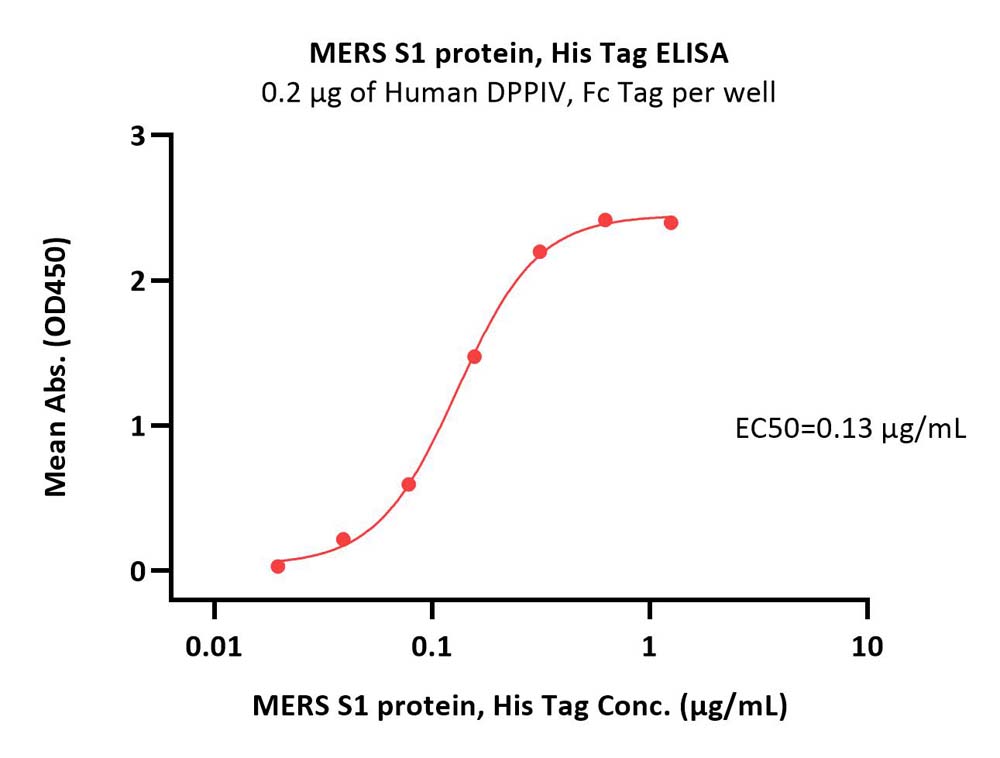分子别名(Synonym)
Spike,S1 protein,Spike glycoprotein Subunit1,S glycoprotein Subunit1,Spike protein S1
表达区间及表达系统(Source)
MERS S1 protein, His Tag (S1N-M52H5) is expressed from human 293 cells (HEK293). It contains AA Tyr 18 - Arg 751 (Accession # K0BRG7-1).
Predicted N-terminus: Tyr 18
Request for sequence
蛋白结构(Molecular Characterization)

This protein carries a polyhistidine tag at the C-terminus.
The protein has a calculated MW of 83.1 kDa. The protein migrates as 90-116 kDa under reducing (R) condition (SDS-PAGE) due to glycosylation.
内毒素(Endotoxin)
Less than 1.0 EU per μg by the LAL method.
纯度(Purity)
>95% as determined by SDS-PAGE.
制剂(Formulation)
Lyophilized from 0.22 μm filtered solution in PBS, pH7.4 with trehalose as protectant.
Contact us for customized product form or formulation.
重构方法(Reconstitution)
Please see Certificate of Analysis for specific instructions.
For best performance, we strongly recommend you to follow the reconstitution protocol provided in the CoA.
存储(Storage)
For long term storage, the product should be stored at lyophilized state at -20°C or lower.
Please avoid repeated freeze-thaw cycles.
This product is stable after storage at:
- -20°C to -70°C for 12 months in lyophilized state;
- -70°C for 3 months under sterile conditions after reconstitution.
质量管理控制体系(QMS)
电泳(SDS-PAGE)

MERS S1 protein, His Tag on SDS-PAGE under reducing (R) condition. The gel was stained with Coomassie Blue. The purity of the protein is greater than 95%.
活性(Bioactivity)-ELISA

Immobilized Human DPPIV, Fc Tag (Cat. No. DP4-H5266) at 2 μg/mL (100 μL/well) can bind MERS S1 protein, His Tag (Cat. No. S1N-M52H5) with a linear range of 0.039-0.156 μg/mL (QC tested).
Protocol
活性(Bioactivity)-SPR

Human DPPIV, His Tag (Cat. No. DP4-H5221) immobilized on CM5 Chip can bind MERS S1 protein, His Tag (Cat. No. S1N-M52H5) with an affinity constant of 0.303 μM as determined in a SPR assay (Biacore 8K) (Routinely tested).
Protocol
背景(Background)
The MERS or Middle East Respiratory Syndrome Coronavirus, is a member of the coronavirus family and is known to cause severe respiratory illness in humans. The MERS protein is a type I transmembrane protein that plays a vital role in the virus's ability to infect host cells. It is composed of three main domains: the extracellular domain, the transmembrane domain, and the cytoplasmic domain. The extracellular domain, further divided into S1 and S2 subunits, is responsible for receptor recognition and binding. The S1 subunit contains the Receptor Binding Domain (RBD), which is crucial for the virus's attachment to and entry into host cells. The RBD specifically interacts with the host cell receptor, facilitating the initial step of infection. The S2 subunit, on the other hand, is responsible for membrane fusion. It contains a fusion peptide that inserts into the host cell membrane, initiating the fusion process. This fusion allows the virus's genetic material to be released into the host cell, initiating the infection process.























































 膜杰作
膜杰作 Star Staining
Star Staining












 Loading ...
Loading ...




